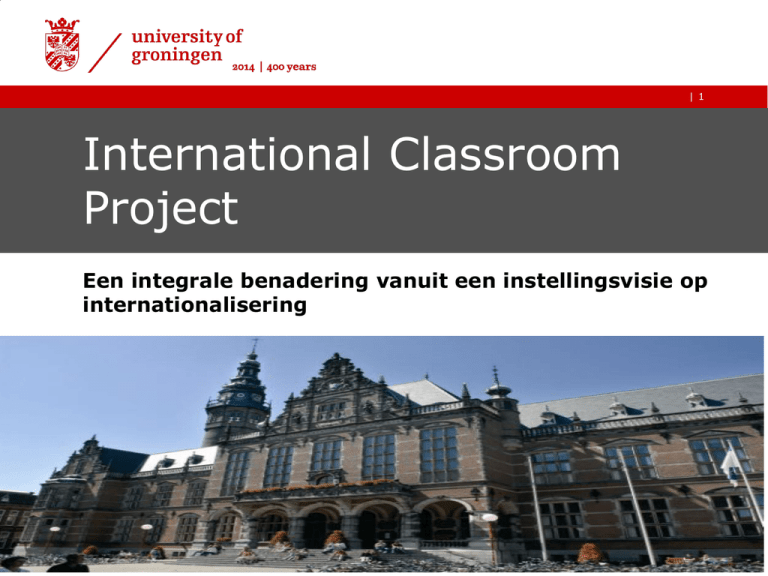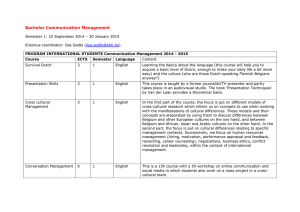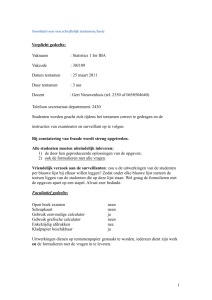International Classroom Project
advertisement

| 1 International Classroom Project Een integrale benadering vanuit een instellingsvisie op internationalisering | | |4 | 3/13/2014 | | | | Martini tower at night 8 | 9 International Classroom Project › Aantallen en ambities › 28,000 studenten totaal - 5,000 internationale studenten: - > 50% PhD studenten - 115 nationaliteiten › > 20% internationale staf (niet-Nederlandse nationaliteit) › 25% study abroad | 10 International Classroom Project › Engelstalige programma’s: > 100 Engelstalige Master’s (146 in total) 21 Engelstalige Bachelor’s (49 in total) 15 Double degree programma’s 8 Erasmus Mundus programma’s. (strategische) partners and networks wereldwijd – op universitair en facultair niveau. | 11 International Classroom Project › Internationalisation 2.0: › Kwaliteitsbenadering/”comprehensive internationalisation” › Meer focus op programma/cursus niveau › Mainstreamen in de organisatie › Focus op diversiteit als resource › Hoe meten en monitoren | 12 International Classroom Project › Kwalitatieve indicatoren/meten van outcomes: › › › › Internationale/interculturele learning outcomes Taal- en interculturele vaardigheden Kwaliteit van internationale partners Beoordeling van onderwijs en organisatie | 13 International Classroom Project Ambities RUG • • • Integreren van internationaal/cultureel diverse groep studenten in een leeromgeving/gemeenschap Bereiken van hoger niveau van onderwijs door het gebruik van diversiteit in achtergrond van studenten Studenten voorbereiden op leven en werken in een globaliserende wereld. | 14 International Classroom Project › Doelstelling › “To contribute to the UoG application for NVAO Distinctive Quality Feature Internationalisation (DQFI) by demonstrating the added value and clarifying institutional conditions of the International Classroom, in relation to both staff and students”. | 15 Vragen “What makes our programmes international? How to use diversity as a resource in the international classroom? How to adjust our policies to realise our vision on internationalisation? How to realise fit for purpose support for our students and staff?” | 16 International Classroom Project Hoe? top-down en bottom-up alle niveaus en stakeholders “good practices” balans tussen model en context onderbouwen met onderzoek/publicaties betrokkenheid van externe experts. | 17 International Classroom Project › Wat? eerste activiteiten › › › › › Missie/visie document Taalbeleid BKO/UTQ beleid Model voor “graduate attributes” Pilot project. | 18 International Classroom Project Waarom? › Mission – who we are › “The University of Groningen offers research-driven education in a wide range of disciplines. We generate and share knowledge, contribute to the innovative development of society and “grand societal challenges”, and prepare students for a life and career in a globalized world”. › › Values › “We highly value our cross-disciplinary character, our work contributes to international developments. We work in a context of academic excellence and integrity, and embrace diversity”. | 19 International Classroom Project › Visie elementen › “inclusive environment (…) › an international perspective throughout research disciplines and degree programmes › an international perspective at the institutional level, reflected in all policies and regulations › using diversity of staff and students as a resource”. | 20 Relevantie voor studenten “Internationalisation is an important aspect of students' education. It broadens their mind, not only in their academic but also in their personal development. In addition to that, it adds to their employability. It broadens their labour market potential and increases their attractiveness to potential national and international employers”. Voor staf “Internationalisation makes the university a more interesting place to study and work. Students and staff are exposed to a potentially larger and more diverse pool of people and ideas. It strengthens knowledge creation, which is the primary aim of any academic venue”. | 21 International classroom project › “Internationalisation of the curriculum is the incorporation of an intercultural and international dimension into the content of the curriculum, as well as the teaching and learning processes and support services of a programme of study. › An internationalised university will engage students with internationally informed research and cultural and linguistic diversity. It will purposefully develop their international and intercultural perspectives as global professionals and citizens” (Leask 2009; p. 209). › › Curriculum (formal, informal and hidden): everything that shapes the students’ learning experience (Leask 2009). | 22 International Classroom Project › Andere activiteiten › “Language policy: enabling, stimulating › Language proficiency as a competence for effective participation and integration, future mobility and employability. › Bi-lingual university fostering linguistic diversity” | 23 International Classroom Project Pilot project – onderzoeksvragen: - wat maakt onze programma’s internationaal? - hoe ontwikkelen we een generiek IC model? | 24 International Classroom Project parameters NVAO: - “international and intercultural learning outcomes - teaching and learning (curriculum, teaching methods, learning environment, assessment) - staff (diversity, international experience, competences, services) - students (diversity, cultural and linguistic competences)”. | 25 International Classroom Project Methodologie interviews met academische staf, management, studenten (QIC – Leask, 2009, and taalaspecten Lauridsen, 2013 ) - - analyse van curriculaire en extra-curriculaire documenten,inclusief student evaluaties - relevante publicaties en onderzoek, inclusief EU projecten. | 26 Project International Classroom Illustrerende citaten – van studenten en staf The medical context… “Whenever I learn anything about myself or about my friends, it is never when we are agreeing on subjects or when we share the same experience. You always learn about other cultures and other perspectives when you discuss it from different angles”. 2nd year student B: Focus Group IBMG 2013 | 27 Meer citaten “They expect you to be able to do academic writing, but you have never done it before. There’s also a lot of diversity in what has been done. I wouldn’t be able to do it in Dutch either, although the language would be a lot better.” A second year IBMG student representative “At the moment we are just guessing why some things work and other things don’t, and so if you know the students personally, it’s easier to approach them, so they can share more, and to understand their experiences better.” Block Coordinator, IBMG | 28 Conclusies 1. Be aware of culture in the widest sense of the word i.e. both local (Dutch) academic culture, and international standards for grading (in Medicine/Spatial Sciences) 2. Use diversity as a resource to generate understanding, scope and innovations for societal problems 3. Be context specific, providing examples which show differences. Examples preferably cover not only Dutch or European experience | 29 Vervolg conclusies 4. Facilitate broader and informal interaction at class level (rather than regulate at program level) 5. Allow for flexibility and adaptation time 6. Direct language support towards qualitative measures (observation and feedback) and contextualised needs e.g. academic writing (students), individually mediated needs (staff) | 30 International Classroom Project IC model (to be developed) learning outcomes/graduate attributes: learner-oriented, process approach include international and intercultural elements more focus on competences and attitude more focus on the use of examples and context explicit use of diversity - to raise quality and satisfaction and generate a richer variety of solutions. | 31 IC model - teaching environment: • give extensive information and guiding about education, culture, and regulations • explicit use of diversity (not only nationality) • adjust learning materials • group collaboration • allow for adjustment time • facilitate interaction and community building • facilitate (English and Dutch) language development and development of cross-cultural communication skills | 32 IC model - assessment and evaluation: • Assume international teaching standards for grading, examination, enrollment, participation • allow for sufficient feedback • facilitate freedom of choice • develop multiple evaluation strategies. | 33 International Classroom Project Hoe verder - discussie en implementatie van het model in pilot faculteiten, plus faculteit Wis- en Natuurkunde - discussie over visie op internationalisering - aanpassen van beleid en regelgeving (strategieplan 2015) - ontwikkelen van een platform, publicaties, seminars, presentaties. | 34 International Classroom Project Discussiepunten: How international and diverse is your classroom? What advantages or disadvantages do you see? What could be improved? What are your needs for feedback/support? What is your experience as a lecturer/ support staff or student? | 35 Bedankt voor jullie aandacht en deelname! Franka van den Hende f.m.van.den.hende@rug.nl www.rug.nl/internationalclassroom





